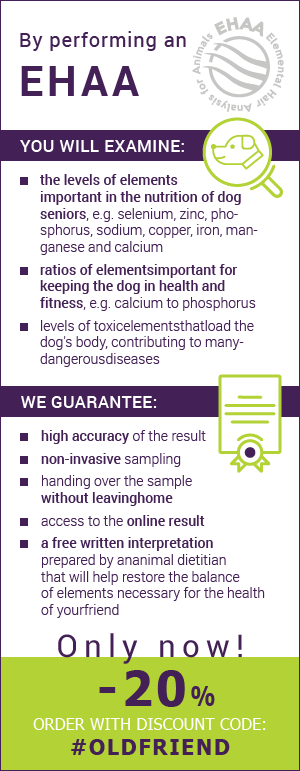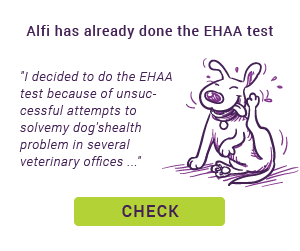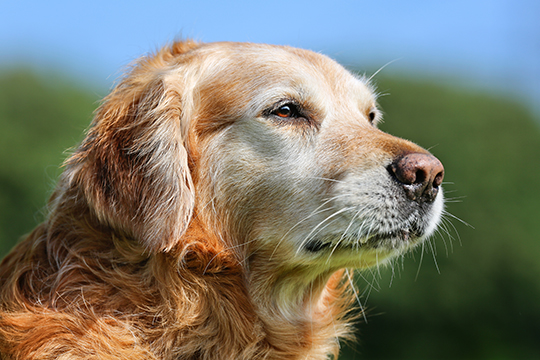Ageing is a natural physiological process in all organisms, and is associated with numerous changes in the functioning of individual organs. As dogs age, metabolic rate and the amount of saliva and gastric juice secreted decrease, as does the surface area of intestinal villi, which results in impaired absorption of nutrients. A way to improve the quality of life for older dogs can be a well-balanced diet and the addition of appropriate macro- and microelements. When choosing supplements, you should look at the current state of health of your dog, which is why each case should be considered individually. It’s also worth remembering that both a deficiency and excess of minerals are dangerous. Therefore, it may be helpful to conduct an EHAA test before changing the diet. This will allow you to determine the elements present in the dog’s body and choose the appropriate dose of supplements. Which minerals should be included in the diet of senior dogs?
ZINC – SUPPORT FOR THE DOG’S SKIN
One problem that’s quite easy to notice is the deterioration of the condition of the coat. With age, the skin loses its elasticity, the hair follicles disappear and baldness occurs. It turns out that in such cases, additional supplementation with zinc and polyunsaturated fatty acids from the n-6 family are helpful. Fatty acids protect the skin against excessive evaporation of water, improving its elasticity. On the other hand, zinc neutralises free radicals, protecting cells and allowing faster regeneration of damaged skin. This element also controls keratin-producing cells (keratinocytes) and can prevent excessive keratinisation of the skin (hyperkeratosis).
In addition to weakening the skin and coat, a zinc deficiency may result in a lack of appetite, vomiting and weight loss. Furthermore, dogs of northern breeds (genetic zinc absorption disorder) and dogs of large breeds (incorrect diet) have a zinc deficiency syndrome – zinc-responsive dermatosis. It manifests with skin parakeratosis (keratosis) of the mouth and paws.
Zinc can be given orally as zinc sulphate; however, this form is recommended mainly in the treatment of dermatoses, and in such a situation, the daily dose is 10 mg/kg of body weight. If you want to improve the condition of your senior dog’s skin and coat, you can simply implement a well-balanced diet rich in natural zinc. Foods of animal origin are an important source of this element. By far the most zinc is found in beef (250 mg/kg db), while the least is in poultry (10 mg/kg). The diet should also include lamb (50 mg/kg), goatling (60 mg/kg), eggs (chicken egg yolk contains over 40 mg of zinc per kilogram), as well as fish. Plant foods definitely have less of this element. It should also be noted that some of them contain phytic acid, which significantly reduces zinc absorption.
IT’S BETTER TO PREVENT THAN TREAT
Studies have shown that selenium supplementation can benefit many elderly dogs. A decrease in cancer incidence was noted, as well as a decrease in DNA damage among senior dogs. There was also an increase in apoptosis, i.e. programmed death of prostate epithelial cells. This mechanism is used to remove used-up cells, and an increase in its intensity can help prevent prostatic hyperplasia. Like zinc, selenium has a positive effect on the condition of the coat – it makes the coat soft and shiny. It’s also recommended to include it in the diet of dogs with cardiovascular diseases. Together with other antioxidants, it has a positive effect on energy production in the heart muscle, the functions of which have been impaired by the disease.
A selenium deficiency leads to loss of appetite, lethargy and difficulty breathing. However, an excess causes weakness, nervousness and pulmonary oedema. Selenium is found in fish (up to 2 mg/kg), meat and cereals (0.3 mg/kg). High concentrations are also found in livers and kidneys.
 ANTIOXIDANTS – HOW TO SLOW AGEING PROCESSES
ANTIOXIDANTS – HOW TO SLOW AGEING PROCESSES
Antioxidants are chemical compounds that remove excess free radicals from the body. Free radicals are molecules that, among others, contribute to accelerated ageing. Antioxidants include some vitamins (A, E, C), carotenoids, and minerals such as copper, iron, manganese and the above-mentioned selenium and zinc. They have a positive effect on the work of the heart, immunity and the functioning of the nervous system, which is very important in older dogs. It has also been proven that the use of selenium, vitamins E and C, as well as polyunsaturated fatty acids EPA and DHA visibly improves cognitive abilities in elderly dogs.
Therefore, when putting meals together, it’s worth considering products rich in these elements, and including meat, offal such as kidneys and heart (sources of copper), spleen and lungs (sources of iron), liver (source of both copper and iron), crustaceans, fish, and plant products – cereal grains, beets, and rice.
HOPE FOR YOUR DOG’S KIDNEYS
One of the most common diseases in older dogs is chronic renal failure. In this case, when deciding on a diet, you should ensure a lower content of phosphorus and sodium (lower limits of the recommended values). Numerous studies have shown that this significantly slows the development of the disease. It’s also advisable to add phosphorus chelators to each meal. These are compounds that bind to phosphorus in the digestive tract and limit its absorption; they also contribute to it being excreted with urine. It’s worth noting that when reducing the amount of phosphorus in the diet, you should also correct the amount of calcium. Keeping the Ca:P ratio at 1.2-1.4:1 will prevent excessive phosphate absorption.
Sources of calcium for dogs include chicken eggshell powder (1 teaspoon ≈ 800-1000 mg of Ca), marine algae or calcium citrate. In the case of phosphorus, these are meat and bone meals (they also contain calcium), cereal products, as well as meat and eggs, which also contain sodium.
HEALTHY TEETH ARE A MUST
Another ailment that older dogs face is tartar. It arises as a result of the mineralisation of plaque and becomes a breeding ground for bacteria that when they multiply in a dog’s mouth can lead to gingivitis. Underestimating this problem results in the exposure of the tooth neck, purulent inflammation, and even the need to extract the tooth. Therefore, it’s worth implementing good oral hygiene for our pets. Products containing polyphosphates (phosphorus compounds) or zinc ions may be helpful. They have antibacterial properties and inhibit the formation of tartar (they capture calcium ions, so that insoluble calcium salts don’t precipitate). Toothpaste, mouthwash, supplements and special oral care foods that contain the above-mentioned ingredients are available in stores. Regular use can prevent your pet from needing mechanical removal of tartar by a veterinarian. This procedure is performed under anaesthesia, and in the case of elderly dog, it isn’t always possible or involves significant risk.
SUMMARY
Most pet owners are afraid of their furry friends ageing. They try not to think about it, because it’s mainly associated with suffering, numerous diseases and disability. We’re not able to prevent dogs from ageing, but with current knowledge about nutrition and the properties of various minerals, we can relieve some of the symptoms and greatly improve the quality of life for senior animals.
Eng. Zootechnician, Katarzyna Żmuda
 LITERATURE
LITERATURE
1. Biel W., Łysoń E. 2018. Antyoksydanty w żywieniu psów. Czwarte warsztaty kynologiczne – pies w służbie, s. 66-68
2. Ceregrzyn M., Barszczewska B., Lechowski R. 2016. Podstawy żywienia psów i kotów. Wydawnictwo Edra Urban & Partner. Wrocław
3. Hensel P. 2010. Nutrition and skin diseases in veterinary medicine. Clinics in Dermatology, nr 28 (6), s. 686-696
4. Horoszewicz E., Pieniak-Lendzion K., Niedziółka R., Łukasiewicz M. 2010. Porównanie zawartości wybranych metali w tkance mięśniowej oraz narządach wewnętrznych koziołków i tryczków. Acta Sci. Pol., Zootechnica, nr 9, s. 15-20
5. Jank M. 2015. Suplementacja diety starszych psów. Magazyn Weterynaryjny, nr 09
6. Jank M. 2014. Fosfor – cichy wróg pacjentów z niewydolnością nerek. Magazyn Weterynaryjny, nr 7, s. 679
7. Milgram N. W., Head E. W., Cotman C. W. 2001. Age-dependent cognitive dysfunction in aged canines: Dietary Intervention. Proceedings of the Third International Congress on Veterinary Behavioral Medicine, s. 53–57
8. Mirowski A. 2013. Cynk w żywieniu psów i kotów. Część III. Wskazania do suplementacji, naturalne źródła pokarmowe. Życie Weterynaryjne, nr 88 (7), s. 569-571
9. Niedziółka R., Pieniak-Lendzion K., Horoszewicz E. 2008. Wpływ czynników żywienia na poziom związków mineralnych w mięsie i narządach wewnętrznych u jagniąt i koźląt. Ekotoksykologia w Ochronie Środowiska, s. 259-264
10. Sharadamma K. C., Purushotham B., Radhakrishna P. M., Abhilekha P. M., Vagdevi H. M. 2011. Role of Selenium in Pets Health and Nutrition: A Review. Asian Journal of Animal Sciences, nr 5 (1), s. 64-70
11. Skibniewska E. M., Kośla T., Skibniewski M., Węgrzyn E., Madyniak R., Oyrzanowska D. 2011. Zawartość Cu, Zn i Mn w wątrobie i nerkach krów z rejonu woj. mazowieckiego. Ochrona Środowiska i Zasobów Naturalnych, nr 47, s. 104-111
12. Skibniewski M., Kośla T., Skibniewska E. M. 2011. Zawartość wybranych mikroelementów w mięśniach krów mlecznych. Ochrona Środowiska i Zasobów Naturalnych, nr 49, s. 135-141
13. Sygocki C. Minerały i witaminy dla psa potrzebne do utrzymania pełni zdrowia. https://vetexpert.eu/blog/skladniki-mineralne-i-witaminy-czego-potrzebuje-twoj-piesdo-utrzymania-pelni-zdrowia
14. Taylor E. J., Adams C., Neville R. 1995. Some nutritional aspects of ageing in dogs and cats. Proceedings of the Nutrition Society, nr 54, s. 645-656












